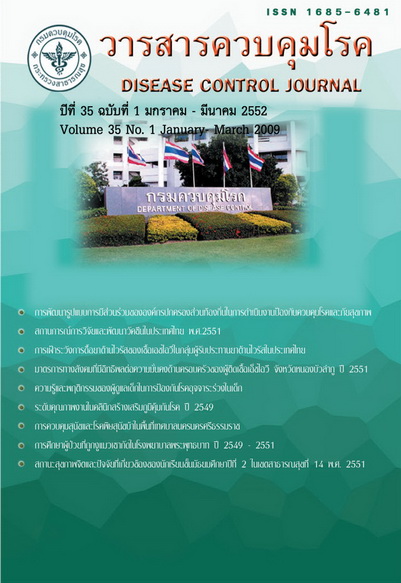Situation of Vaccine Research and Development in Thailand in 2008
Keywords:
Research and Development in Vaccine, Vaccine self relianceAbstract
This descriptive study was conducted to review the current situation of vaccine research and development in Thailand. It was designed to study visit the research organizations and their supporting unit. There were 6 related organizations. (Center for Vaccine Development, Faculty of Medicine Siriraj Hospital, Medical Biotechnology Center, National Center for Genetic Engineering and Biotechnology, Vaccine Trial Center, National Laboratory Animal Center). It was found that the potential of the research organizations was modest. There were many vaccines developed to prevent communicable diseases which were the major public health problems with appropriate technology. (Dengue vaccine, JE vaccine, HIV vaccine, Influenza and Avian influenza vaccine) But no vaccine against malaria, leptospirosis were developed, nor could be expected in the recent future. The new technologies such as genetic engineering were required for future projection. In clinical level, many clinical trials in Thailand were conducted in accordance with Good Clinical Practice. In contrast, the preclinical studies were lack of expertise in managing researches to meet Good Laboratory Practice standard. The infrastructures included standard laboratories and pilot plant were also available. The human resources and training, funding and animal models especially primate and ferret were not sufficient. The most important things which was urgently necessary was how to fill the gaps between preclinical, clinical and industrial process development. There were some co-operation between local and regional organizations, but national and international partnership still to develop. National vaccine policy was established and set the priority of necessary vaccines. But the policy had not well recognized and implementation. In conclusion, vaccine development in Thailand were not well developed. The essential elements of success were the development of potential and infrastructures of research and development, the authorized organization for driving the policy and research co-operation. These key factors were crucial for Thailand long term vaccine self reliance.
Downloads
References
2. อัตราป่วยเปรียบเทียบกับอัตราการครอบคลุมของวัคซีนสำหรับโรคที่ป้องกันได้ด้วยวัคซีน พ.ศ.2520-2546. กรมควบคุมโรค กระทรวงสาธารณสุข พ.ศ. 2547.
3. การสำรวจความครอบคลุมของการได้รับวัคซีนพื้นฐานและวัคซีนโปลิโอ ในการรณรงค์ พ.ศ.2546. กลุ่มโรคติดต่อที่ป้องกันได้ด้วยวัคซีน สำนักโรคติดต่อทั่วไป กรมควบคุมโรค กระทรวงสาธารณสุข พ.ศ. 2547: 19.
4. ปริมาณการใช้วัคซีนในภาครัฐและเอกชน ในประเทศไทย พ.ศ. 2547.สำนักโรคติดต่อทั่วไป กรมควบคุมโรค กระทรวงสาธารณสุข พ.ศ. 2547.
5. ประมาณการจำนวนวัคซีนที่ต้องการใช้ในภาครัฐ พ.ศ. 2548-2552. สำนักโรคติดต่อทั่วไป กรมควบคุมโรค กระทรวงสาธารณสุข พ.ศ. 2547.
6. WHO. Influenza. Fact Sheet 211. Revised 2003.
7. Fiore A, Shay D, Haber P, Iskander J, Uyeki T, Mootrey G, et al. Prevention and Control of Influenza: Recommendations of the Advisory Committee on Immunisation Practises(ACIP). MMWR 2007; 56(RRO6): 1-54.
8. WHO. Influenza vaccines. Weekly Epidemiol Record 2005; 80(33): 277-88.
9. Serdobova I, Kieny MP. Assembling a Global Vaccine Development Pipeline for Infectious Diseases in The Developing World. Am J Public Health 2006; 96: 1554-9.
10. Buckland BC. The process of development challenge for a new vaccine. Nat Med 2005; (suppl): S 16-9.
11. Struck MM. The future of vaccines: an industrial perspective. Vaccine 2001; 20 (suppl. 1): S101-3.
12. Milstein JB, Gaule P, Kaddar M. Access to vaccine technologies in developing countries: Brazil and India. Vaccine 2007; 25: 7610-9.
13. Struck MM. Vaccine Research and product development success rates and development times. Nat Biotechnol 1996; 14: 591-3.
14. Jadhav S, Datla M, Kreeftenberg H, Hendriks J. The Developing Countries Vaccine Manufacturers' Network (DCVMN) is a critical constituency to ensure access to vaccines in developing countries. Vaccine 2008; 26: 1611-5.
15. Initiative on Public-Private Partnerships for Health (IPPPH). Available at http://www.ippph.org/.Accessed July 1, 2005.
16. International Aids Vaccine Initiative. Available at http://www.iavi.org/.Accessed July 1, 2005.
17. Andre FE. How the research-based industry approaches vaccine development and establishes priorities. Dev Biol(Basel). 2002; 110: 25-9.
18. Mahoney RT, Ramachandran S, Xu Z. The introduction of new vaccines into developing countries II :Vaccine financing. Vaccine 2000; 18: 2625-2635.
19. The 10/90 Report on health research 2001-2002. Davey S, ed. Global forum for health research 2002.
20. Lessons Learned: New Procurement Strategies for Vaccines. Final Report to the GAVI Board. Mercer Management Consulting; 2002. Available at: http://www.vaccinealliance.org/resources/lessons_learned_draft_final.pdf.AccessedJuly 1, 2005.
21. Levine R, Kremer M, Albright A. Making markets for vaccines. Ideas to action. Available at: http://www.cgdev.org/ doc/books/vaccine/MakingMarkets-complete.pdf.Accessed August 4, 2006.
22. Batson A, The Problems and Promise of Vaccine Markets In Developing Countries. Health Affairs
2005; 24(3): 690-3
Downloads
Published
How to Cite
Issue
Section
License
Articles published in the Disease Control Journal are considered as academic work, research or analysis of the personal opinion of the authors, not the opinion of the Thailand Department of Disease Control or editorial team. The authors must be responsible for their articles.






